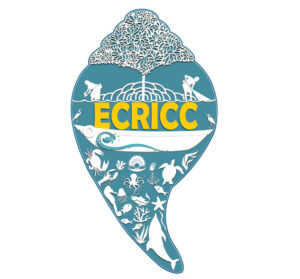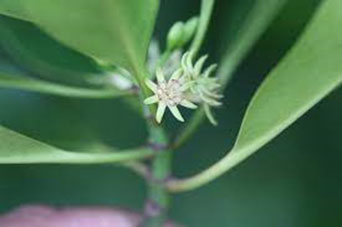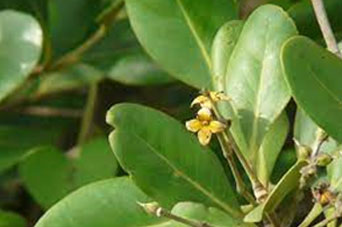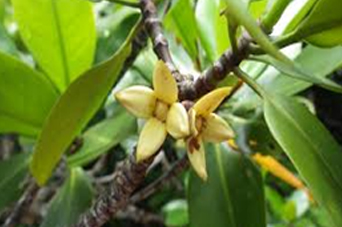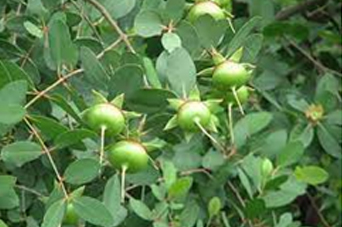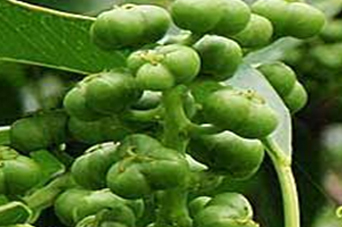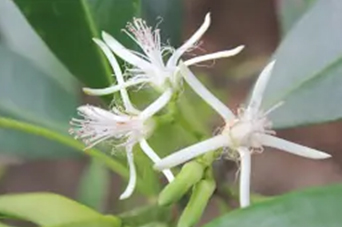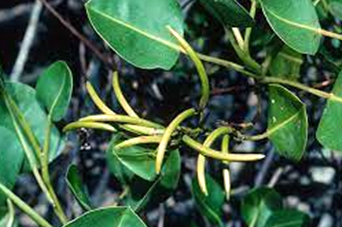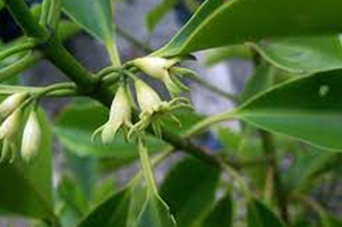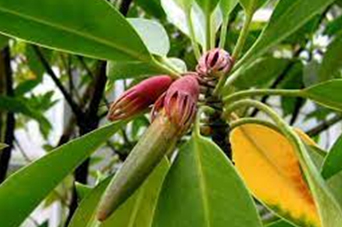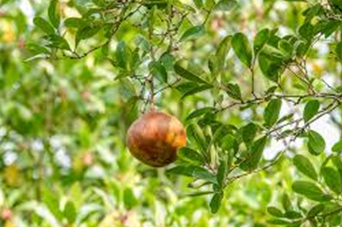Extent of Mangroves Globally
Mangrove shrubs/forests occur worldwide in the tropics and subtropics, largely restricted mainly between latitudes 25° North and 25° South. The northern extensions occur in Japan (31°22’N) and Bermuda(32°20’N); while the southern extensions are in New Zealand (38°03’S), Australia (38°45’S) and on the east coast of South Africa. They require warm saline water, therefore they are situated along the tropical coastlines, on the saltwater coasts of 113 tropical and subtropical countries, totalling more than 137,000 square kilometres (85,000 square miles) or 14.79 million hectares. Approximately 75% of the world’s mangrove forests are concentrated in just 15 countries.

The largest Mangrove area is reported in Asia (5.55 million hectares), followed by Africa (3.24 million hectares), North and Central America (2.57 million hectares) and South America (2.13 million hectares). Around 40% of the mangroves are found in Southeast Asia and South Asia only. As per the State of the Worlds Mangroves 2021, more than 40% of the total area of Mangroves were reported to be in just four countries with Indonesia with the largest 19% coverage of the total, followed by Brazil (9%), Nigeria (7%) and Mexico (6%). Malaysia, Papua New Guinea and Australia also have large mangrove vegetation.
Status of Mangroves in India
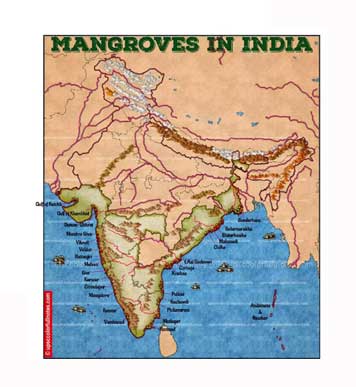
India has Mangrove vegetation of 4992 sq. km, distributed across nine states and three union territories as per the India’s State of Forest Report 2021. India’s total mangrove cover is 0.15% of the country’s total geographical area and 3.3% of world’s total mangrove cover. Very Dense Mangrove comprises 1,475 sq. km (29.55%); moderately dense mangrove is 1.481 sq. km (29.67 %), while open mangroves constitute an area of 2,036 sq. km (40.78%). A gain of 54 sq. km (1.10%) of mangrove cover was observed in the eastern coast between 2017 to 2019. Similarly, a net increase of 946 sq. km (23%) of mangrove is observed in a span of 35 years, between 1987 – 2021.
The mangrove distribution in India is more in the eastern coast compared to the western coast. The presence of western ghats makes the western coast deeply shelved with vertical slopes, lack deltas and river estuaries. Whereas the eastern coast has long estuaries with larger deltas and runoffs due to the presence of mighty rivers. The smooth slopes caused by the river basins provides larger areas for mangrove colonisation. Additionally, the presence of deltaic alluvium in the eastern coast support greatly the mangrove vegetation and its natural regeneration.
The major mangrove forest in eastern coast are – Sundarbans (West Bengal), Bhitarkanika (Odisha), Godavari – Krishna delta (Andhra Pradesh), Pichavaram (Tamil Nadu), Baratang Island (Andaman and Nicobar Island) and in the western coast are the Gulf of Kutch (Gujarat), Thane creek (Maharashtra), and Chorao Island (Goa).
Sundarbans houses the highest mangrove, followed by Gujarat and Andamans and Nicobar Islands. The Sunderbans mangroves, located in the Bay of Bengal are partly in India and partly in Bangladesh and is the world’s biggest single patch of mangrove forests. Sundari (Heritiera fomes) mangrove trees are in abundance in the bay region, and it is presumed to have got its name from this dominant mangrove species. The deltas of the Godavari, Krishna Mahanadi and Kollidam rivers (in the Eastern Coast of India), have smaller patches of mangroves. The highest number of mangroves sites in a state of India, is in Maharashtra with 10 sites and Odisha is second on list with 7 sites. For more information (Mangrove Habitats in India)
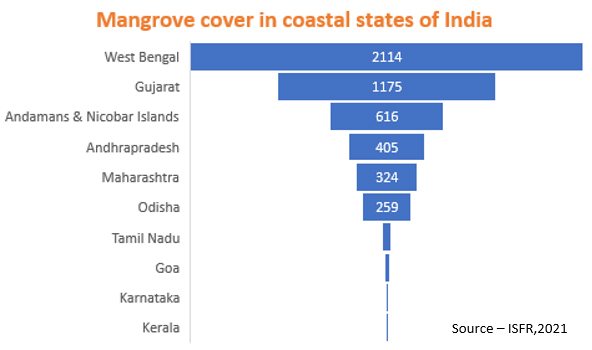
Sundarbans is the world’s largest single patch of Mangrove Forests. It is also the first mangroves in the world to be put under scientific management.
It is estimated that 69 species of mangroves are found in India of which, 63 species are present in east coast, 37 species on the western coast, and 44 species on the bay Islands. The important species of Mangrove ecosystems found in India include Avicennia officinalis, Rhizophora mucronata, Sonneratia alba, Avicennia Alba, Bruguiera cylindrica, Heritiera littoralis, Phoenix paludosa, nnand Ceriops tagal.
Status of Mangroves in Odisha
Odisha has 258.98 sq. km of mangrove forest cover, which is 5.18% of the country’s mangrove cover as of 2021. Odisha stands 6th in mangrove forest cover in India, and the mangrove forests comprises of 80.43 sq. km of very dense, 94.31 sq. km of moderately dense and 84.24 sq. km of open mangroves.
Odisha have significant gain of Mangrove Forests in past few years
Kendrapara district houses major share of 209 sq. km (81%) of mangrove forests, followed by Bhadrak of 34.87 sq. km (13.46%), Jagatsinghpur with 8.33 sq. km (3.2%), Balasore with 5.40 sq. km (2%), and Puri with 1.13 sq. km. Bhitarkanika, the second largest mangrove forest of India, lies in Kendrapada district. This has 31 species, whereas Sundarbans have 27, and the Andaman & Nicobar islands have 24 species.
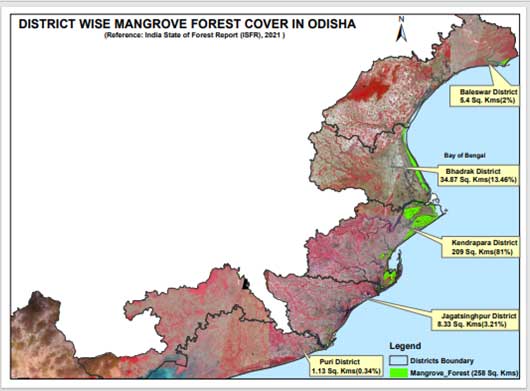
Odisha’s coastline is classified into three – the north, middle and the south coastal plain. The north coastal plain (within the Subarnarekha to the Baitarani estuaries) have mostly the salt tolerant species or the luxuriant mangroves. The mangroves shrubs in northern coastal Odisha are comparatively short heighted that characterizes both estuarine and riverine ecosystem conducive for mangrove habitats and species. The middle coastal plain (from the Baitarani to the Devi estuary) have dense mangroves and the south coastal plains (from Astarang to the Bahuda estuary) have mangroves associates and mixed forests.
The vegetation along Odisha coast is largely of littoral, salt bush and tidal mangrove or mixed forest types. The mangroves are dense at Kalibhanjadian (Dhamara mouth), Bhitarkanika, Nasi, Jatadhar and Saharabedi, and rest of the coasts have mixed vegetation. The coasts stretching Konark to Prayagi have tidal scrub jungles. The carbon stockpile quantity from plants and in soils in north coastal mangrove areas of Odisha have potentiality of carbon sequestration and are within 3.4–4.1Tg C that combat the climatic extremes.
Bitarkanika is the second largest mangroves forest of India
The mangrove species diversity is highest in Odisha, and the commonly found Mangrove species along Odisha’s coast are:
- Mangroves and their species
- Status of Mangroves
- Advantages of Mangroves over other coastal plants
- Mangroves usefulness for wildlife
- Benefits of Mangroves to human communities
- Mangrove’s contribution to the carbon cycle & climate resilience
- Threats to Mangroves and their ecosystem
- Conservation and protection measures for Mangroves in India
- Role of communities in conservation and protection of Mangroves
